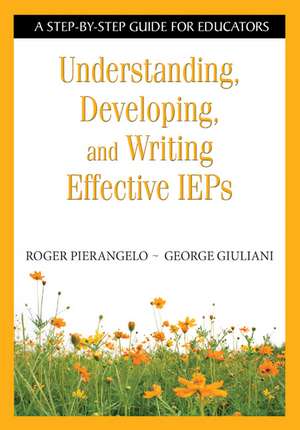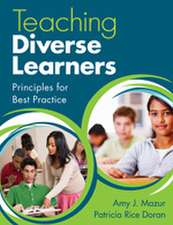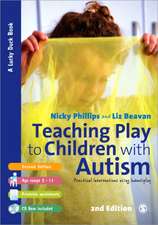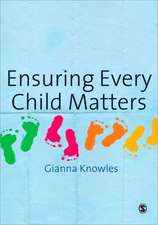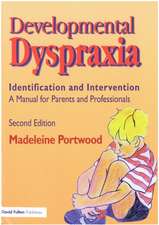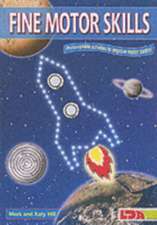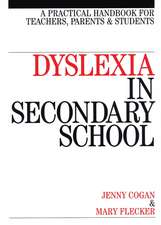Understanding, Developing, and Writing Effective IEPs: A Step-by-Step Guide for Educators
Autor Roger Pierangelo, George A. Giulianien Limba Engleză Paperback – 22 mai 2007
Preț: 293.57 lei
Nou
Puncte Express: 440
Preț estimativ în valută:
56.18€ • 61.00$ • 47.19£
56.18€ • 61.00$ • 47.19£
Carte tipărită la comandă
Livrare economică 23 aprilie-07 mai
Preluare comenzi: 021 569.72.76
Specificații
ISBN-13: 9781412917865
ISBN-10: 1412917867
Pagini: 176
Dimensiuni: 178 x 254 x 11 mm
Greutate: 0.39 kg
Ediția:1
Editura: SAGE Publications
Colecția Corwin
Locul publicării:Thousand Oaks, United States
ISBN-10: 1412917867
Pagini: 176
Dimensiuni: 178 x 254 x 11 mm
Greutate: 0.39 kg
Ediția:1
Editura: SAGE Publications
Colecția Corwin
Locul publicării:Thousand Oaks, United States
Recenzii
"The authors tackle an often complex process in an understandable, sequential manner."
Cuprins
Preface
Acknowledgments
About the Authors
Introduction
1. Foundational Issues in Individualized Education Programs (IEPs)
Introduction
Purpose of an IEP
13 Principles of IEP Collaboration
2. IEP Preparation
Preparation Before the IEP Meeting
Setting Up the IEP Meeting
Giving Notice of an IEP Meeting
When an IEP Meeting Must Be Convened
Helping Students Prepare
Characteristics of an Effective IEP Team Meeting
3. IEP Participants
IEP Team Members--Roles and Responsibilities
Excusal of Team Members
Questions and Answers About Other IEP Team-Related Topics
4. IEP Team Meetings
The Team Process
During the Meeting--Focused but Flexible
Guidelines for Running the IEP Meeting
5. Step-by-Step Development of the IEP
Step 1: Formulate a Statement of the Student's Present Level of Academic Achievement of Functional Performance
Step 2: Determine the Four Need Areas
Step 3: Consideration of Special Factors
Step 4: Determination of Measurable Annual Goals (Including Academic and Functional Goals)
Step 5: Reporting Progress Toward the Annual Goals to Parents
Step 6: Determine the Extent to Which the Student Will Not Be Able to Participate in General Education Programs (LRE Explanation)
Step 7: Determine Placement Options
Step 8: Determine Related Services
Step 9: Determine Program Modifications, Accommodations, Supplementary Aids, and Services
Step 10: Determine the Need for Assistive Technology Devices and Services
Step 11: Determine the Supports for School Personnel on Behalf of the Student
Step 12: Determine the Ability of a Student to Participate in State and District Assessments
Step 13: Determine Extended School Year (ESY) Services
Step 14: A Statement of Secondary Transition Service Needs and Needed Transition Services for Students
Step 15: Develop a Statement of Transfer of Parental Rights to the Student Upon Reaching the Age of Majority
Annual Review and Revision of the IEP
Recommendations Upon Declassification
Appendix: Individuals with Disabilities Education Improvement Act of 2004--Section on IEPs (Enrolled as Agreed to or Passed by Both House and Senate)
Glossary
References and Suggested Readings
Index
Acknowledgments
About the Authors
Introduction
1. Foundational Issues in Individualized Education Programs (IEPs)
Introduction
Purpose of an IEP
13 Principles of IEP Collaboration
2. IEP Preparation
Preparation Before the IEP Meeting
Setting Up the IEP Meeting
Giving Notice of an IEP Meeting
When an IEP Meeting Must Be Convened
Helping Students Prepare
Characteristics of an Effective IEP Team Meeting
3. IEP Participants
IEP Team Members--Roles and Responsibilities
Excusal of Team Members
Questions and Answers About Other IEP Team-Related Topics
4. IEP Team Meetings
The Team Process
During the Meeting--Focused but Flexible
Guidelines for Running the IEP Meeting
5. Step-by-Step Development of the IEP
Step 1: Formulate a Statement of the Student's Present Level of Academic Achievement of Functional Performance
Step 2: Determine the Four Need Areas
Step 3: Consideration of Special Factors
Step 4: Determination of Measurable Annual Goals (Including Academic and Functional Goals)
Step 5: Reporting Progress Toward the Annual Goals to Parents
Step 6: Determine the Extent to Which the Student Will Not Be Able to Participate in General Education Programs (LRE Explanation)
Step 7: Determine Placement Options
Step 8: Determine Related Services
Step 9: Determine Program Modifications, Accommodations, Supplementary Aids, and Services
Step 10: Determine the Need for Assistive Technology Devices and Services
Step 11: Determine the Supports for School Personnel on Behalf of the Student
Step 12: Determine the Ability of a Student to Participate in State and District Assessments
Step 13: Determine Extended School Year (ESY) Services
Step 14: A Statement of Secondary Transition Service Needs and Needed Transition Services for Students
Step 15: Develop a Statement of Transfer of Parental Rights to the Student Upon Reaching the Age of Majority
Annual Review and Revision of the IEP
Recommendations Upon Declassification
Appendix: Individuals with Disabilities Education Improvement Act of 2004--Section on IEPs (Enrolled as Agreed to or Passed by Both House and Senate)
Glossary
References and Suggested Readings
Index
Notă biografică
Roger Pierangelo is an associate professor in the Department of Special Education and Literacy at Long Island University. He has been an administrator of special education programs and served for eighteen years as a permanent member of Committees on Special Education. He has over thirty years of experience in the public school system as a general education classroom teacher and school psychologist, and is a consultant to numerous private and public schools, PTAs, and SEPTA groups. Pierangelo has also been an evaluator for the New York State Office of Vocational and Rehabilitative Services and a director of a private clinic. He is a New York State licensed clinical psychologist, certified school psychologist, and a Board Certified Diplomate Fellow in Child and Adolescent Psychology and Forensic Psychology. Pierangelo is currently president of The National Association of Special Education Teachers, executive director of The American Academy of Special Education Professionals, and vice-president of The National Association of Parents with Children in Special Education.
Pierangelo earned his BS degree from St. John¿s University, his MS from Queens College, Professional Diploma from Queens College, PhD from Yeshiva University, and Diplomate Fellow in Child and Adolescent Psychology and Forensic Psychology from the International College of Professional Psychology. He is a member of the American Psychological Association, New York State Psychological Association, Nassau County Psychological Association, New York State Union of Teachers, and Phi Delta Kappa.
Pierangelo is the coauthor of numerous books, including The Big Book of Special Education Resources and The Step-by-Step Book Series for Special Educators.
Pierangelo earned his BS degree from St. John¿s University, his MS from Queens College, Professional Diploma from Queens College, PhD from Yeshiva University, and Diplomate Fellow in Child and Adolescent Psychology and Forensic Psychology from the International College of Professional Psychology. He is a member of the American Psychological Association, New York State Psychological Association, Nassau County Psychological Association, New York State Union of Teachers, and Phi Delta Kappa.
Pierangelo is the coauthor of numerous books, including The Big Book of Special Education Resources and The Step-by-Step Book Series for Special Educators.
Descriere
Written by legal and education experts and aligned with the reauthorization of IDEA 2004, this practical resource provides a step-by-step plan for creating, writing, and evaluating IEPs.
